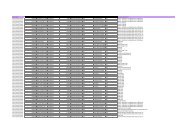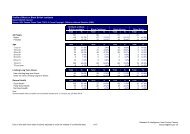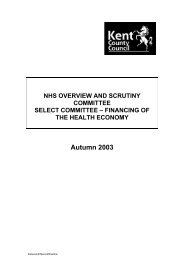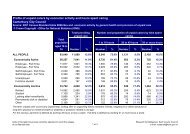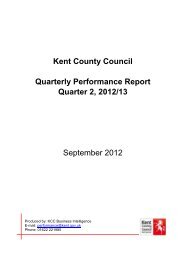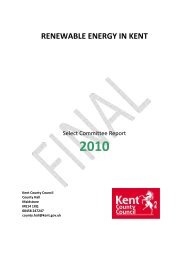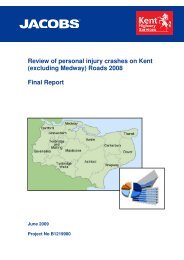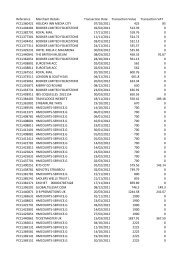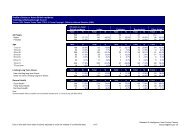Benenden Walk - Walk Through Time
Benenden Walk - Walk Through Time
Benenden Walk - Walk Through Time
Create successful ePaper yourself
Turn your PDF publications into a flip-book with our unique Google optimized e-Paper software.
<strong>Benenden</strong> <strong>Walk</strong><br />
10.7 miles (17.2kms) allow 5.5 hours<br />
A <strong>Walk</strong> T h<br />
rough <strong>Time</strong>
<strong>Benenden</strong> <strong>Walk</strong><br />
distance 10.7 miles (17.2kms) allow 5.5 hours<br />
This 10-mile circular walk around the village of <strong>Benenden</strong> shows the western part of Kent at its best. The route follows the<br />
established High Weald Landscape Trail through small fields, orchards and woodland. There are superb views over the Weald from<br />
St George’s Church, <strong>Benenden</strong>, and the footpath leading back to Cranbrook.<br />
The full route takes in the parkland that makes up the grounds of <strong>Benenden</strong> School, and the ancient culvert at Strawberry Wood,<br />
crossing the Roman Road below Stream Farm and the site of an original Roman ford, capturing the historic features and rural<br />
character of Kent’s High Weald perfectly.
A History of <strong>Benenden</strong><br />
South of Cranbrook is the picturesque village of <strong>Benenden</strong>, which prospered from the 14th century as an important centre of the<br />
Wealden iron and cloth industries. Before that, the name indicates that it was one of the dens, or woodland clearings, common in<br />
this area of the Weald, where Saxon farmers drove their domestic pig herds from the north and south downs every autumn to feed<br />
on the fallen acorns, chestnuts and beechnuts that littered the forest floor - a practice that was known as pannage. The trackways<br />
they established from driving their animals to the forest and back again all ran north-south and developed into the roads in use<br />
today. The clearings were originally owned by parishes settled earlier in the open lands of the north and south, who wanted to use<br />
the forest resources. Eventually, settlements became established around them from the 7th century, growing into the many villages<br />
in the Weald with the suffix den. Pannage continued until the Norman conquest, when lands were divided and allocated by William<br />
the Conqueror.<br />
Cricket has been played for hundreds of years on the village green, which was formerly common land of <strong>Benenden</strong> Manor,<br />
before being given to the village in 1928.
Strawberry Wood Culvert<br />
The culvert is old and substantial and although designed to allow heavy loads to pass over it, its original function is still unknown.<br />
It may have been built to transport iron ore from local quarries to furnaces that existed in the area or perhaps sandstone, brick clay<br />
or marl – other materials that were commonly quarried in the Weald.<br />
From the 15th century to the 17th century <strong>Benenden</strong> prospered from cloth working, and the culvert would have also provided safe<br />
crossing for the transport of heavy broadcloth to nearby fulling mills.<br />
The culvert was restored in 2009 by skilled craftsmen using local stone after a survey a couple of years earlier has discovered the<br />
structure was close to collapse. Flood waters rushing down the ghyll had deposited tons of silt and debris, completely covering the<br />
entrance and damaging some of the huge sandstone flag stones which supported the roof. A trackside interpretation panel has<br />
been installed which includes information about the history of the culvert and the restoration project.
<strong>Walk</strong>ing Notes<br />
Church House<br />
This is a 10-mile walk, if the entire route is followed. There are a number of short cuts which can be taken if time is<br />
limited, or a shorter walk preferred. On the whole, the route offers easy walking, although there are some gentle<br />
inclines due to the rolling nature of the High Weald. A large part of the walk follows the High Weald Landscape<br />
Trail, which is an accessible route, clearly marked, and conditions are good underfoot. The route includes fields<br />
of pasture, occasionally containing sheep and cattle. Refreshments are available from the village shop, the King<br />
William IV and the Bull public houses in <strong>Benenden</strong>, and the Woodcock pub in Iden Green.<br />
The walk begins and ends in Cranbrook,<br />
where there is free parking in the large<br />
car park by the Co-op supermarket off<br />
the High Street.<br />
From the Weald Information Centre,<br />
walk up the path, passing St Dunstan’s<br />
Church on your right, and on leaving the<br />
churchyard, keep to the right and follow<br />
the path at the bottom edge of the open<br />
space known as Ball Field – a greenspace<br />
donated to the town.<br />
Next to the churchyard is Church House,<br />
a 15th century building, formerly<br />
Dence’s Charity School. From the path,<br />
you can see Cranbrook School, which<br />
succeeded Dence’s School.<br />
Cross the road at the far end of Ball<br />
Field, follow the path until you are directed<br />
right to join the High Weald Landscape<br />
Trail. Follow the path round the wood and<br />
St Dunstan’s Church<br />
St George’s Church<br />
over the bridge, through the field and up<br />
to the road. Turn right along the road, and<br />
after 100m turn left along a driveway. Carry<br />
on and go through the orchard.<br />
Continue along the left boundary and<br />
go through the gate in the hedge. Follow<br />
the path with the hedge on your right<br />
and through two more gates. Note the<br />
Old Cloth Hall on your left – a building<br />
whose name refers to the cloth industry<br />
that made Cranbrook wealthy from the<br />
14th century. From this point, you can also<br />
see Coursehorn, now the site of Dulwich<br />
Preparatory School.<br />
Continue walking along the High<br />
Weald Landscape Trail until you get to a<br />
shaw, or small wood. Go down the steps,<br />
over the bridge and up the other side of<br />
the field beyond. The path leads along the<br />
right boundary of the field, go straight on<br />
at the corner, until you enter a copse.<br />
Bear left up the slope ahead and to the<br />
right of the barn, meeting a track, where<br />
you turn left, then right after a few metres,<br />
heading towards Crabtree Farm. Follow<br />
the track round the cottage garden, past<br />
the pond on your left, then into a wood.<br />
Go over the footbridge and up through a<br />
kissing gate into a field. Head for the gap<br />
straight ahead and up across the field<br />
before entering the grounds of <strong>Benenden</strong><br />
School. Continue to follow the High Weald<br />
Landscape Trail, keeping the school on<br />
your left until you reach the drive, where<br />
you turn right on to the main road.<br />
You can take a short cut by turning right<br />
at the entrance to the school. Cross the<br />
road to find the High Weald Landscape<br />
Trail leading past a pond, and follow the<br />
route of the old Roman road travelling<br />
towards Stream Farm.<br />
St Dunstan’s Church is known locally as the cathedral of the Weald, due to its<br />
impressive size. The present building dates from the 15th century, but it is believed<br />
that the monks of Canterbury founded a church on the site much earlier - around<br />
1030. You will find more information about its history inside the church, which is<br />
well worth taking the time to visit.<br />
If you want to visit Strawberry Wood<br />
Culvert, head left along the road<br />
towards <strong>Benenden</strong>. At the crossroads in<br />
the village you’ll see the beautiful Old<br />
Manor House, originally moated, which<br />
incorporates a medieval open hall built<br />
in 1390. The Old Manor is probably the<br />
oldest-surviving house in the parish.
<strong>Benenden</strong> School<br />
<strong>Benenden</strong> School was originally at<br />
the centre of the Hemsted Estate<br />
(meaning homestead), which was<br />
granted to Richard Guldeford by King<br />
Richard II. It has an even more ancient<br />
history – a Roman settlement was<br />
discovered in the school grounds<br />
in the 1950s, at the intersection<br />
of Roman roads. The seat of Lord<br />
Cranbook, the house was rebuilt in<br />
1860, and expanded further in 1912<br />
by Lord Rothermere. The school was<br />
founded in 1923, and was attended by<br />
the Princess Royal.<br />
On the site of the old Toll House is the<br />
Queen’s Well, built to celebrate Queen<br />
Victoria’s Jubilee. Opposite the village<br />
green is Gibbon’s School, built in 1609<br />
by Edmund Gibbon, a clothier and local<br />
benefactor. The school is still in use.<br />
Turn right at the village green and head<br />
towards St George’s Church. There has<br />
been a church on this site since 1086,<br />
when it was listed in the Domesday<br />
Book. However, its roof was set alight<br />
during a storm in December 1672, and<br />
the church was destroyed, to be rebuilt<br />
in 1677. Its present interior owes much<br />
to Lord Cranbrook, who redesigned it in<br />
1861. If you have time, look inside the<br />
church and find the millennium tapestry<br />
on the right as you enter through the<br />
main door.<br />
From the church steps, bear left<br />
through the churchyard and go through<br />
the gate, keeping the field boundary on<br />
your right. Pass over stiles and through<br />
gates. Bear right, keeping on the High<br />
Weald Landscape Trail heading south<br />
and noting the wonderful views towards<br />
Hastings and Fairlight. Pass a pond on<br />
your right, and when you reach the track,<br />
turn right, and after a short distance<br />
climb over the stile taking the footpath<br />
left across the fields to Strawberry Wood.<br />
Pass through the gate and continue down<br />
a woodland track towards the ancient<br />
Strawberry Wood Culvert, which was fully<br />
restored in 2009.<br />
Short cut (avoiding Strawberry<br />
Wood Culvert)<br />
Bear right before the church and follow the<br />
lane around the churchyard, then into a<br />
paddock and follow the path over a series<br />
of stiles down to the road. Cross over the<br />
road and follow the grass track down to the<br />
entrance gate of Stream Farm.<br />
Strawberry Wood Culvert<br />
Long <strong>Walk</strong> (via Strawberry Wood<br />
Culvert<br />
From the culvert, follow the path down<br />
to the lane, taking the time to admire the<br />
historic boundary on the left as you emerge<br />
from the wood. Turn right when you reach<br />
the lane, taking care as you walk up it. At the<br />
top of the hill is the 17th century Woodcock<br />
Inn; a fine halfway house serving quality<br />
food and beers.<br />
Opposite the pub, the path leads along a<br />
track by the side of a wood, past the sewage<br />
works and up through an orchard. At the top<br />
of the orchard, bear left along the boundary<br />
of the houses until you reach the road. Turn<br />
right and walk down the pavement until you<br />
reach the footpath straight ahead where the<br />
road bends to the left. <strong>Walk</strong> straight across<br />
a field until you reach a track and go up it a<br />
short distance before turning left, following<br />
the line of the fence. The path emerges at<br />
a surfaced footpath, where you turn right<br />
up the hill, and walk back up towards St<br />
George’s Church. Follow the path as it turns<br />
back on itself through a paddock over a<br />
series of stiles down to the road, taking<br />
in the view of the countryside towards<br />
Cranbrook. Cross over the road and follow<br />
the grass track down to the entrance gate of<br />
Stream Farm.<br />
Follow the path right over a stile and<br />
below the boundary of the farm. Go through<br />
a gate, bear right through a field and up<br />
to a stile. Climb over the stile and you will<br />
emerge above Scullsgate House. Turn left<br />
on to the road – a historic drove routeway<br />
and lane. Turn right down the road and<br />
take the left-hand fork, until you reach<br />
Little Nineveh.<br />
Nineveh was an ancient Middle Eastern<br />
city, founded by the Assyrians, and is<br />
now Mosul, in Iraq. In the book of Jonah,<br />
in the Bible, Nineveh is depicted as “a<br />
wicked city worthy of destruction”. It<br />
is possible that the name is linked to<br />
the properties owned in the past by<br />
Dissenters – people who split from the<br />
established Church.<br />
Beyond Little Nineveh take the<br />
footpath on the right that travels up the<br />
hill and through the edge of the wood.<br />
Continue on through the fields up to the<br />
road and turn left. After approximately<br />
100 metres, at the corner of the road,<br />
take the footpath that leads across the<br />
fields towards Swattenden, following the<br />
hedge on your left. Pass the pond and<br />
look for a gap in the hedge, where you<br />
turn right. Follow the hedge-line to a gap<br />
and go over the footbridge through a<br />
small orchard. Bear left to another gap in<br />
the hedge, then go around the corner of<br />
the field to the road. Cross the road with<br />
care. Go into a copse and follow the path<br />
on the right edge of the field until you<br />
reach a waymark pointing left across the<br />
field. Follow the line to meet a hedge and<br />
continue walking, keeping the hedge on<br />
your right. Go through into the next field<br />
and bear left. This will bring you on to a<br />
track travelling past The Freight.<br />
The Freight is a historic farmstead<br />
dating back to the 15th century,<br />
although it is thought there may have<br />
been a farm on the site before the<br />
1400s. The house was rebuilt in the<br />
16th century, and in 1675 the owner,<br />
Richard Road, was fined £20 for holding<br />
a Presbyterian meeting in his house.<br />
Continue along the track past Mount<br />
Ephraim (a house whose name may refer<br />
to an owner who was also a Dissenter),<br />
and at the top of Freight Lane bear left, go<br />
down an alleyway and out into the Crane<br />
Valley. Follow the path through the valley<br />
towards the High Street, and turn right.<br />
You will find yourself back at the Weald<br />
Information Centre.
Key<br />
Circular <strong>Walk</strong> - 10.7 miles (17.2 km) Allow 5.5 hrs<br />
Shortcut - 7.8 miles (12.5 km) Allow 4 hrs<br />
Shortcut - 8.2 miles (13.1 km) Allow 4.5 hrs<br />
Stile<br />
Parking<br />
Museum<br />
Gate<br />
Take Care<br />
Pub PC Public toilets<br />
Picnic site Visitor attraction<br />
Start / Finish<br />
0<br />
0 0.5<br />
1<br />
Kilometres<br />
Miles<br />
0 0.45<br />
0.9<br />
© Crown Copyright and database right 2011. Ordnance Survey 100019238
Broadcloth<br />
Old Cloth Hall<br />
Broadcloth is the name given to densely-woven material, measuring up to 30 yards long (approximately 10 metres), by 5 foot<br />
wide (1.2 metres). The cloth was made from wool, carded and spun into yarn, then woven on broad looms. Weaving was a cottage<br />
industry dating from the medieval period. It was carried out in so many houses in the area, that it is estimated that a third of the<br />
Kentish cloth trade was centred around Cranbrook.<br />
Once woven, the broadcloth was fulled, a process where the oils and dirt in the cloth are washed out by pounding it with hammers<br />
driven by the wheels of watermills. Fulling thickens the cloth, which is then stretched on wooden frames, or tenters and held in<br />
place with tenterhooks – hence the expression meaning held in suspense.
The ‘<strong>Walk</strong> <strong>Through</strong> <strong>Time</strong>’ walking guides have been produced by<br />
Cranbrook In Bloom in partnership with the Kent High Weald Partnership.<br />
For more information visit www.walkthroughtime.co.uk<br />
This walk has been produced in partnership<br />
with:<br />
<strong>Walk</strong>s available in this series:<br />
• Bedgebury<br />
• <strong>Benenden</strong><br />
• Cranbrook<br />
• Goudhurst<br />
• Sissinghurst<br />
Photography courtesy of: Brian Brent,<br />
Frank Page, Trisha Fermor and Ian<br />
Johnstone. Images are under copyright<br />
and cannot be re-produced without<br />
owner’s permission.<br />
Please respect the beautiful countryside you are walking through by<br />
following the Countryside Code:<br />
• Be safe, plan ahead and follow any signs<br />
• Leave gates and property as you find them<br />
• Protect plants and animals and take your litter home<br />
• Keep dogs under close control<br />
• Consider other people





